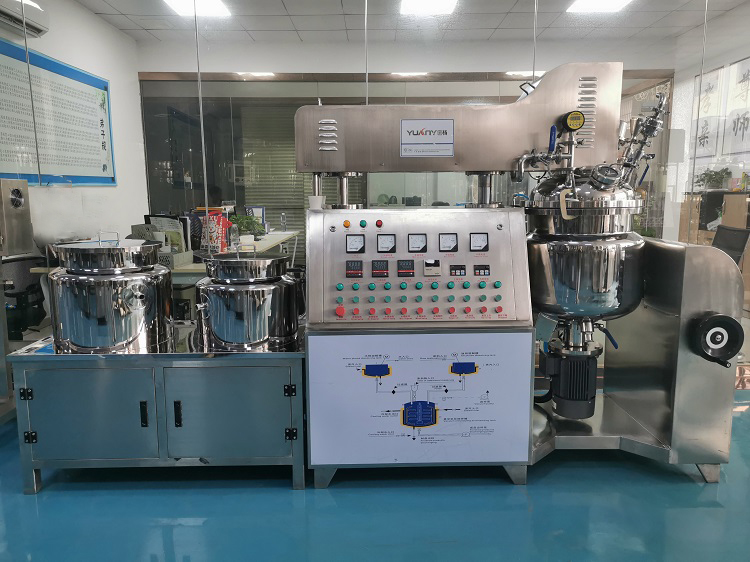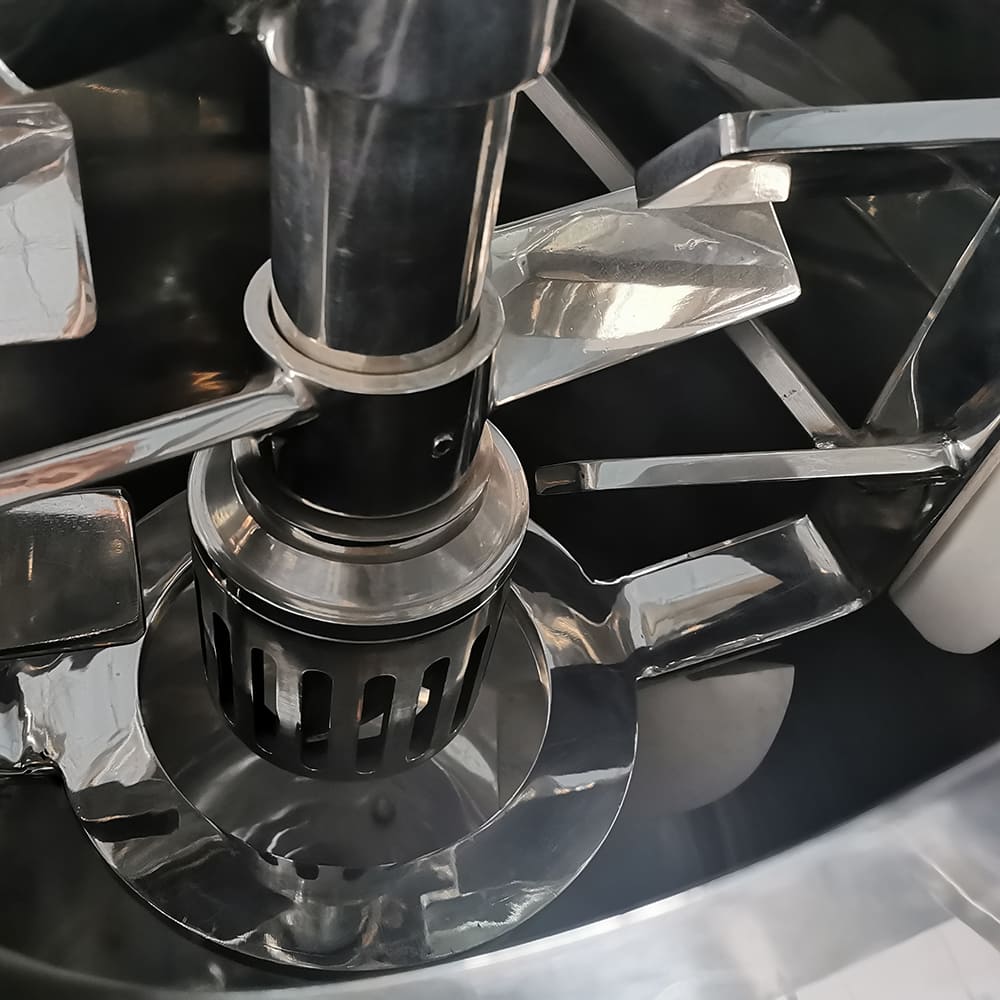How a High-Speed Vacuum Emulsifier Improves Cream Fineness and Stability | Cosmetic Cream Production Equipment
Explore how advanced vacuum emulsifiers and cosmetic-making machines enhance cream fineness, stability, and production efficiency. Learn how cosmetic cream production equipment drives quality and sales growth.
- How a High-Speed Vacuum Emulsifier Revolutionized Cream Production: Enhancing Fineness and Stability
- Why Cream Fineness and Stability Matter in Cosmetics
- Understanding the Challenges: Layering and Graininess in Creams
- The Problem of Product Layering
- Grainy Texture and Consumer Perception
- The Role of High-Speed Vacuum Emulsification in Cosmetic Manufacturing
- What is high-speed vacuum emulsification?
- German Technology Integration: Precision and Power
- Technical Advantages of the High-Speed Vacuum Emulsifier
- Powerful Shearing and Emulsifying Capacity
- Vacuum Defoaming and Stability Enhancement
- Programmable Logic Control (PLC) for Process Consistency
- Real-World Impact: Transforming Production and Product Quality
- Dramatic Reduction in Production Time
- Enhanced Cream Texture and Appearance
- Consistent Color Retention
- Business Benefits: Sales Growth and Market Expansion
- Reduced Customer Complaints and Higher Satisfaction
- Boosted Online Ratings and Repeat Purchases
- Attraction of New Distributors
- Conclusion: A Strategic Upgrade Driving Quality and Competitiveness
- Frequently Asked Questions
How a High-Speed Vacuum Emulsifier Revolutionized Cream Production: Enhancing Fineness and Stability
Why Cream Fineness and Stability Matter in Cosmetics
In the highly competitive cosmetics industry, product texture and stability significantly influence consumer satisfaction and brand reputation. Creams that feel smooth, consistent, and stable over time foster trust and encourage repeat purchases. Yet, many skincare manufacturers struggle with issues like product layering, grainy textures, and rapid degradation — all of which undermine the user experience.
For brands committed to natural ingredients and premium quality, overcoming these challenges is critical. Recently, a skincare company specializing in natural formulations achieved a remarkable breakthrough by integrating a high-speed vacuum emulsifier—a key piece of cosmetic cream production equipment—into their production line. This article explores how this advanced cosmetic-making machine improved their cream fineness and stability while boosting production efficiency and market performance.

Understanding the Challenges: Layering and Graininess in Creams
The Problem of Product Layering
Product layering occurs when oil and water phases in an emulsion separate over time, causing visible stratification. This separation not only detracts from aesthetic appeal but also signals instability to consumers, raising concerns about product efficacy and safety.
Grainy Texture and Consumer Perception
A grainy or uneven texture often results from inadequate emulsification, where oil droplets fail to break down sufficiently or mix uniformly with water. Such texture negatively impacts sensory experience, making creams less desirable and diminishing perceived value.
The Role of High-Speed Vacuum Emulsification in Cosmetic Manufacturing
What is high-speed vacuum emulsification?
High-speed vacuum emulsification involves rapidly mixing oil and water phases under vacuum conditions using specialized cosmetic cream production equipment. The vacuum removes trapped air, preventing bubbles and oxidation, while the high shear forces break down droplets to micron or even sub-micron sizes.
German Technology Integration: Precision and Power
The vacuum emulsifier in question employs cutting-edge German engineering that combines powerful mechanical shearing with precise control systems. This cosmetic-making machine ensures consistent emulsification, uniform particle size distribution, and enhanced product homogeneity.
Technical Advantages of the High-Speed Vacuum Emulsifier
Powerful Shearing and Emulsifying Capacity
The high rotational speed generates intense shear forces, which effectively reduce droplet size. Smaller droplets improve cream smoothness and facilitate better absorption when applied to the skin.
Vacuum Defoaming and Stability Enhancement
Vacuum conditions eliminate entrapped air, which can cause foam formation and oxidation of sensitive ingredients. This process results in a more stable emulsion, reducing the likelihood of separation and color changes during shelf life.
Programmable Logic Control (PLC) for Process Consistency
Equipped with a PLC system, this cosmetic cream production equipment allows precise control over mixing speed, duration, and vacuum pressure. This automation minimizes human error, ensures batch-to-batch uniformity, and simplifies operator training.

Real-World Impact: Transforming Production and Product Quality
Dramatic Reduction in Production Time
Prior to the upgrade, each batch required six hours to emulsify properly. With the high-speed vacuum emulsifier, production time was halved to just three hours. This significant efficiency gain enables higher throughput without sacrificing quality.
Enhanced Cream Texture and Appearance
The client reported a notable improvement in cream smoothness and delicacy. Post-production testing showed no signs of layering even after three months of storage, confirming the long-term stability of the product.
Consistent Color Retention
Because oxidation was minimized by vacuum mixing, the cream’s natural color remained vibrant and uniform over time, improving consumer appeal.
Business Benefits: Sales Growth and Market Expansion
Reduced Customer Complaints and Higher Satisfaction
By solving texture and stability problems with advanced cosmetic cream production equipment, the client saw a 30% drop in product complaints. This translated directly into stronger customer loyalty and fewer returns.
Boosted Online Ratings and Repeat Purchases
E-commerce ratings improved from an average of 4.2 to 4.7 stars, reflecting the better product experience. Higher ratings fueled a nearly 40% increase in sales, particularly in online channels.
Attraction of New Distributors
The technical upgrade enhanced brand credibility, helping the company gain interest from new distributors eager to offer high-quality skincare products made using state-of-the-art cosmetic-making machines.
Conclusion: A Strategic Upgrade Driving Quality and Competitiveness
Implementing a high-speed vacuum emulsifier represents a pivotal advancement for cosmetic manufacturers facing emulsification challenges. By ensuring finer particle size, improved stability, and shorter production cycles, this cosmetic cream production equipment not only elevates product quality but also strengthens operational efficiency and market position. The featured skincare brand’s experience exemplifies how investing in innovative cosmetic making machines can lead to tangible business success, including higher consumer satisfaction, increased sales, and expanded distribution opportunities.
Frequently Asked Questions
1. How does vacuum emulsification differ from traditional mixing?
Vacuum emulsification removes trapped air during mixing, reducing foam and oxidation. Traditional mixers often allow air incorporation, leading to instability and texture issues.
2. Can a high-speed vacuum emulsifier handle natural ingredient formulations?
Yes, it is particularly effective for natural ingredients prone to separation or degradation, ensuring better homogeneity and shelf life.
3. What are the energy requirements for a high-speed vacuum emulsifier?
Modern emulsifiers are designed for energy efficiency, often consuming less power per batch due to shorter processing times.
4. Is specialized training needed to operate this equipment?
The PLC control system simplifies operation, reducing the learning curve and minimizing human error.
5. How does improved cream stability impact brand reputation?
Stable, high-quality creams lead to fewer customer complaints and higher satisfaction, which enhances brand trust and competitive advantage.

Ultimate Guide to Filling Machine 2026 : Application & Selection

Emulsion Mixer Mastery: Industrial High-Performance Use

Ultimate Guide: Differences Between Homogenizer & Emulsifier

Why Your RO Systems Make Noise: Causes & Fixes

What Is an Emulsion Mixer? Industrial Guide 2026
Industries
How extensive is your global after-sales support network?
We have a global after-sales support network that covers multiple regions to ensure that customers can receive quick responses no matter where they are located.
Liquid Soap Mixer Machine
Do you also provide liquid soap formula and technical training for a new user?
Yes, Yuany is experienced in liquid soap production for many years. We can provide professional training and teach face to face for clients. Don’t hesitate to contact us.
Ink Jet Printer
What else can the bottle coding machine print others except date?
Yes, the date coding machine can print batch number, logo, product name, production date, expiration date, number, bar code, QR code, pictures, etc.
Semi automatic powder filling machine
What’s the filling range of the powder dosing machine?
The filling range of the semi auto powder filling machines is: 10-5000g. But we need to customize according to specific weight that clients plan to pack. The screw model will be different.
Single Layer Agitator Tank
Does the mixing tanks have cooling function?
The single layer mix tank has no cooling function. If you client need cooling function, will customize at least two layers with one jacket for cooling purpose.
Leave a message
Have any questions or concerns about our products? Please leave us a message here, and our team will get back to you promptly.






 Scan QR Code
Scan QR Code
Facebook
YouTube
LinkedIn
Whatsapp: +8613434139712
Guangzhou Yuanyang Machinery